How can you not believe in evolution?
I don’t have time to do a full blog post today (or any day this week, apparently), but I do want to share this with visitors. Pay close attention to the statistics regarding U.S. education — it’s disturbing.

How can you not believe in evolution?
I don’t have time to do a full blog post today (or any day this week, apparently), but I do want to share this with visitors. Pay close attention to the statistics regarding U.S. education — it’s disturbing.
And what they’re not supposed to do.
As I travel across northern Arizona by helicopter, escorting two paying passengers among Arizona’s natural and semi-natural wonders, I find myself working remotely on a book project I started before I left and will finish when I return. I promised to keep the ball moving while away and that means reviewing edits of chapters I’ve completed.
It does not mean getting angry about editors overstepping their bounds and making manuscript changes they have no business making.
In an effort to educate writers and editors about the various editing jobs out there, I decided to put together this list of editor job types and duties. I’m hoping that my project editor and the miscellaneous editors she’s managing will read this and learn.
Rather than discuss all kinds of editors, I’ll concentrate on just two: technical editor and copy editor. These are the ones I work with directly most often — and the ones that give me the most headaches.
A technical editor’s job is to ensure that a book’s content is accurate and instructions are easy to follow. Technical editors are widely used in the computer books I write, although for many of my titles, I’m responsible for my own technical accuracy. When a technical editor is put on a job, his duties include the following:
A technical editor should not — I repeat, not — do the following:
Under no circumstances should the technical editor make changes to the manuscript to introduce information or instructions that he has not verified. The author should never be required to perform technical editing chores on text introduced by the technical editor. It must be assumed by the author that the technical editor’s comments and suggestions are accurate and correct. Otherwise, why have a technical editor?
A copy editor’s job is to review the manuscript and make sure the text is grammatically correct and conforms to the style guidelines established for the publication. The copy editor’s job is to improve the book, not change it. Specifically, his responsibilities include:
The copy editor should not do the following:
There are good copy editors, bad copy editors, and copy editors who should not be copy editors at all. I love having a good copy editor; I love feeling that a revised sentence remains in my own voice but is improved. I love to learn from that. A bad copy editor, on the other hand, won’t find the errors he’s supposed to find. It’s embarrassing when they’re found in the printed book. A copy editor who makes changes for the sake of changes — as if to justify his own importance to the project — should not be editing. He should be either writing his own books or doing something that has nothing to do with writing. These copy editors create bad feelings for experienced authors and make their work a real chore.
What are your thoughts on this? Are you a writer with some editor stories to share? Or an editor with some author stories to share? Please share your comments on this post. I’d like to get a discussion going about this. I think I’m on track with this assessment, but maybe you have other ideas?
In the meantime, I’ve got to make a phone call. One of my editors needs to be reminded of her responsibilities and their limitations.
There are still opportunities for photography after the sun goes down.
I know I’ve written about this before in this blog, but it’s worth repeating: I like taking photos at night. I like the way the light illuminates the things we don’t notice during the day. I like the weird colors of the light sources. I like the deep shadows and the way some things seem to come out of darkness.
Grand Canyon Village, with its rustic, historic buildings, is one of my favorite places to photograph at night. And since I was so lazy yesterday afternoon, I thought I’d make up for it by taking my camera and tripod for a walk from Bright Angel Lodge, where I’m staying, to the El Tovar Hotel, which just happens to have a nice bar.
These are some of the shots I took along the way.
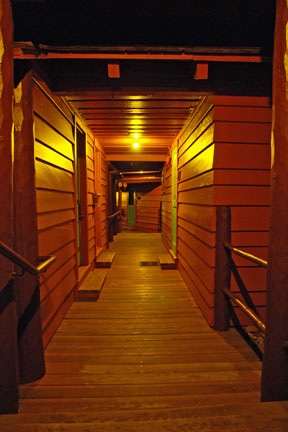
The historic Bright Angel Lodge is a series of stone and wood buildings along the South Rim of the Grand Canyon. The main lodge building houses the lobby, a museum, restaurants, and various service desks. The other lodge buildings are cross-shaped and house small, simple guest rooms like the one I usually stay in. And then there are cabins with two or four guest rooms per building.
Covered, wooden plank walkways run between many of the buildings. They’re illuminated at night and glow rusty red from the red-painted walls.
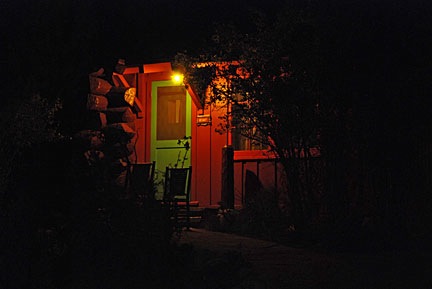
The cabins at Bright Angel Lodge are scattered along the rim. They’re all unique. Some have partial views into the canyon. Others are hidden away among the trees alongside the gravel parking lot.
At night, the doors to some of the cabins glow with a friendly, almost beckoning light. This one, facing into the canyon, seems to await the return of its occupants, who left chairs out front to watch the sunset from their room.
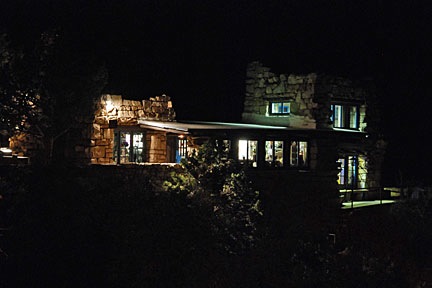
Lookout Studio is another of Mary Colter’s designs. This historic building now houses a gift shop. But if you come to the canyon, walk in and through the building. You’ll emerge on the other side, on the top level of a terraced overlook. Climb down for a good spot to watch sunsets or condors or tourists.
The building is lighted mostly from within at night. The wooden trim around its windows is painted a bright teal green.
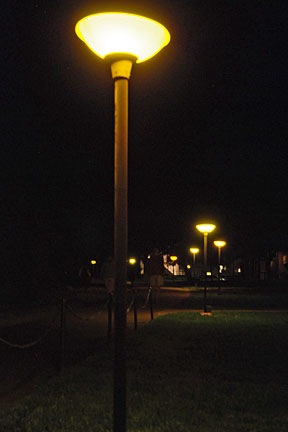
Subdued lighting lines the path between the main building of Bright Angel Lodge and El Tovar Hotel. The lights are just bright enough to ensure that you don’t trip or bump into a grazing deer or elk along the path at night — but no brighter.
Although they line the path in even intervals, the curve of the path gives them the appearance of random blobs of light ahead.
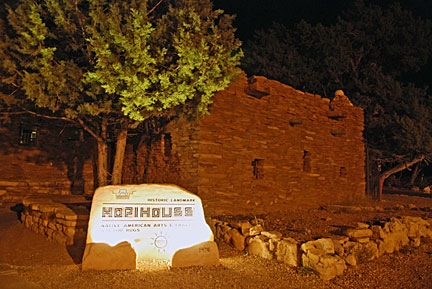
Mary Colter also designed Hopi House, which is currently set up as a gift shop and gallery. She based her design on the architecture of Pueblo indian tribes such as the Hopi. In the old days — the early 1900s — Native American peoples actually lived in upper floors and on the roof of the building.
The building’s stone walls are a textural delight for anyone who admires such things. Set roughly, the stones cast deep shadows on the walls at almost any time of day. At night, things are a bit more subdued.
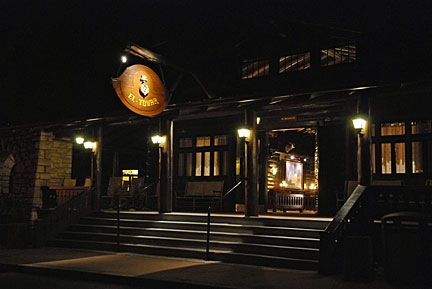
El Tovar, which was completed around 1905, is the grand hotel of the Canyon. When finished, it was hailed as the finest hotel in the west.
Made of dark wood with large porches and pitched roofs, El Tovar seems more in place in a densely forested mountain setting than at the rim of a desert canyon. Last night, its sign seemed to glow and its wide open doors welcomed visitors into the lobby.
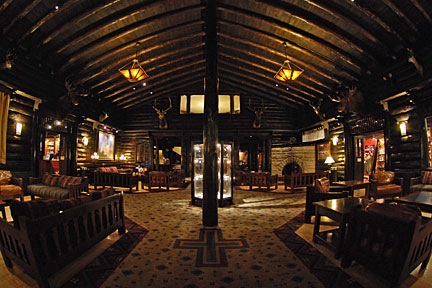
The lobby of El Tovar is an impressive collection of mounted wildlife heads, southwestern decor carpets, plus leather sofas in seating areas, and gift shop displays. Last night, a young woman sat in a corner with her laptop, probably surfing the Web — the lobby is one of the few places where WiFi might be available.
I captured this shot with my fisheye lens, which is why it appears distorted around the edges. I like the symmetry of this shot.

One of the highlights of El Tovar is this round jewelry case in the middle of the lobby. FIlled with the finest quality, handmade Native American jewelry sparkling under bright lights, it’s like looking into a museum display.
I used my fisheye lens for this shot, too. Although intended mostly as an experiment, I thought it was good enough to share here.
By the time I reached this point, it was 9 PM — too late for the martini I had on my mind when I left my room. But I stepped into the bar anyway. It was nearly deserted. I sat at the bar and ordered an Irish Coffee. The bartender made me the best one I’d ever had, complete with a single sugar cube, fresh whipped cream, and a bit of creme d’menthe for color and minty flavor.
When I finished, I set my tripod on my shoulder and walked back to my room. I nearly bumped into a mule deer doe and her fawn along the way.
And yes, I was the only photographer out last night.
And why I didn’t finish this post right after I started it.
I’m at the Grand Canyon. Again.
I come here 20 to 30 times a year, often on helicopter charters. This time, I’m taking a couple from Montana on a Southwest Circle Helicopter Adventure. That’s a 6-day/5-night excursion. The second day (and night) is spent at the South Rim of the Grand Canyon.

A fisheye view of my room at the Bright Angel Lodge. Simple and relatively cheap.
As usual, I have one of the tiny rooms in the Bright Angel Lodge. The historic lodge and cabin buildings were designed by Mary Colter and built in the early 1900s. My room lacks the features most guests take for granted: television, air conditioning, and shower. I don’t need the first two and the third is down the hall.
I lucked out this trip and wound up with a corner room that has windows on two sides. There’s even a window in the bathroom. But best of all, it’s literally 100 feet from the rim of the canyon. In fact, if I look out one of my windows, I can see the wall of the North Rim 10 or 15 miles away.
Not bad for $80 a night.
My passengers are staying at the Thunderbird Lodge, with a partial view of the canyon. Their room is modern and has all amenities. It also cost $180 per night.

A shot taken in passing on my way to lunch today. The clouds were great; they really added depth to the scene.
This trip, for some reason, is different than the others. I didn’t feel at all motivated to walk along the rim and shoot pictures. I think I’m tired of photographing the Grand Canyon. Is that possible?
I have hundreds of photos of this place. But none of them can really capture its magnificence. Every time I try, I’m disappointed. I feel that it’s time to stop trying.
So I spent most of the afternoon in my hotel room, pulling movies off SD cards to clear them for more movies, catching up on Twitter and e-mail, and putting a few videos online. By 5 PM, I realized that I was avoiding my photographic duties. And that made me wonder why I considered taking photos a “duty.” Almost as if it were a chore. Was it?
I sat down to write this post. I entered the title in my offline editor. And then I stopped and scolded myself.
No, I was not going to miss a beautiful Grand Canyon sunset. I was going to get my ass outside and walk along the rim. I didn’t have to take photos, but I could if I wanted to. It was more important to be outside, in the fresh air, on a beautiful late summer afternoon with one of the world’s Natural Wonders in front of me.
So I went outside with my camera. Less than a minute later, I was on the Rim near the Lookout Studio, admiring the way the late afternoon sunlight played on the buttes and canyon walls right in front of my face.
There were lots of other people out there. Most were moving about, snapping photos along the way. Many spoke in languages other than English. They were all ages, although I can’t say I noticed any school-age kids.

El Tovar, in the late afternoon light.
I noticed an artist sitting on a rock with an easel in front of him. This week is the Grand Canyon Celebration of Art: Plein Air Event & Modern Masters Show. The artist, Sedona-based Williamson Tapia, was using oils to paint his interpretation of the cliff on which El Tovar Hotel sits and the magnificent clouds above it. His piece was mostly clouds.
We chatted for a while about art and the Canyon as I watched the light change. The red light and deep shadows behind the buttes were calling me. I excused myself, ducked through Lookout Studio to the cliffside overlooks below it, and snapped a few photos.

A look into the Grand Canyon in the light of the setting sun. The dark and hazy canyon is Bright Angel Canyon.
I shot RAW + JPEG Fine. I don’t usually shoot RAW. I’m hoping that I can learn more about it and use it to make better photos. I figure that I can’t learn more about RAW unless I have some photos to work with. So today was the day to start collecting them. The JPEG Fine will give me some thing easy to play with until I’m ready to work with the RAW format images.
When I was finished, I went back. Will claimed I’d given him good luck; that he’d found his style for the painting. We chatted some more as he worked. I watched him paint the green bushes and trees on the cliff below the hotel and then touch up the clouds with bright white tops and lavender gray bottoms. The light got softer and redder, but it didn’t affect his work; he was painting something completely different, something he saw. Onlookers came and went, admiring his work. None lingered. We continued to talk, agreeing (among other things) that one day a week, there should be no television broadcasts.
Finally, the light faded to the point that he couldn’t continue his work. He stepped aside and I got a good look at it. He told me he’d put it in the fridge back where he was staying so the oil would stay pliable. If those clouds were back the next day, he’d continue working on it to finish it.
We exchanged cards, shook hands, and went our different ways. I came right back to my room to finish the blog post I’d started with a title two hours before.
Now, as I listen to the crickets outside my window, I wish I’d spent the day outdoors, exploring some new part of the Rim.
A costly let down.
Today, four days before I was supposed to accompany two pilots as they flew my helicopter from Seattle to Phoenix, I received an e-mail message from one of the pilots. He claimed that his companion couldn’t get time off from work for the trip. Since he couldn’t afford to make the flight on his own, he was going to have to cancel. I should contact one of my “backups” to make the trip with me.
There are no backups. There were two other pilots interested in making the flight, but I told them that the seats were already taken. That was two months ago, when these clowns said they’d do the flight. Did these guys think I had a room full of pilots waiting for them to back out? Or that most people can drop everything to arrange a spur-of-the-moment, two-day trip between Seattle and Phoenix? Or that I can get someone else on my insurance that quickly?
Yes, I’d planned this flight two months ago. I was in Washington State with the helicopter for cherry drying season and I knew I needed to get the helicopter back. I put the word out to the five people I had on a list who’d said they were interested in doing ferry flights with me. Two dropped out right away because of date conflicts. I chose one of the guys who was left because I’d flown with him before. Back then, he’d asked if he could do the return trip and I told him I’d keep him in mind. He was a known. The other two were unknowns. I went with the known. He was bringing along his student pilot to share the costs. Seemed like a good plan.
The trip had several date changes. At first, it was August. Then I gave him a choice between late August or Labor Day week in September. He chose September. We were supposed to go on Wednesday, but my helicopter is waiting for a part, so I had to push it back to Friday.
I was assured there would be no problem right up until I got the e-mail message this morning.
The bastard was too cowardly to call. (That rumor about me being able to beat people to a pulp over a phone line is simply not true.)
Clearly, he knew he wasn’t going for at least a week. If he planned to go, he would have bought his return plane ticket. I bought my ticket up there as soon as I had a solid date — nearly two weeks ago. He probably never bought his. Never made an investment in the flight. Nothing to lose by canceling.
Shitheel.
The trip will cost me over $3,000. I expected to receive almost that much from the pilots renting my aircraft for the flight. It would have been an almost break-even ferry flight. They would have built R44 time for about half the cost of renting one through the usual channels. I would have had my helicopter moved 1,000 miles for next to nothing.
But now I’m scrambling for paying passengers or other pilots willing to take their place.
In the end, Mike will likely go up to Seattle with me and we’ll share flying duties for the return flight. It’ll be a very costly two days together.
What amazes me about this is how completely irresponsible and inconsiderate some people can be. Not only are these clowns costing me at least $3,000, but they caused me to let down two other pilots who likely would have done the entire flight with me.
I wonder how reliable these guys will be when employed as pilots. Will they fail to show up at work for their week on at the Canyon? Sleep late when they need to pick up passengers in the Gulf? Cut corners on the routes when running tours in Hawaii? Let accident victims die because they don’t feel like firing up the medevac helicopter so medics can scrape them off the pavement?
Do I sound angry? I am.
Jeez, I would never do this kind of thing to someone.
But, as my friend Jim reminded me this afternoon, I’ve been riding with Lady Luck for quite a while now. Gotta take the bad with the good. So I’ll cough up the money and try not to think about it.
As for the little bastard that cost me all this money, I just hope he’s stupid enough to put me or one of my friends down on his resumé as a reference.
Interested in making the flight? Check out the Craig’s List listing if you don’t mind me doing the flying.